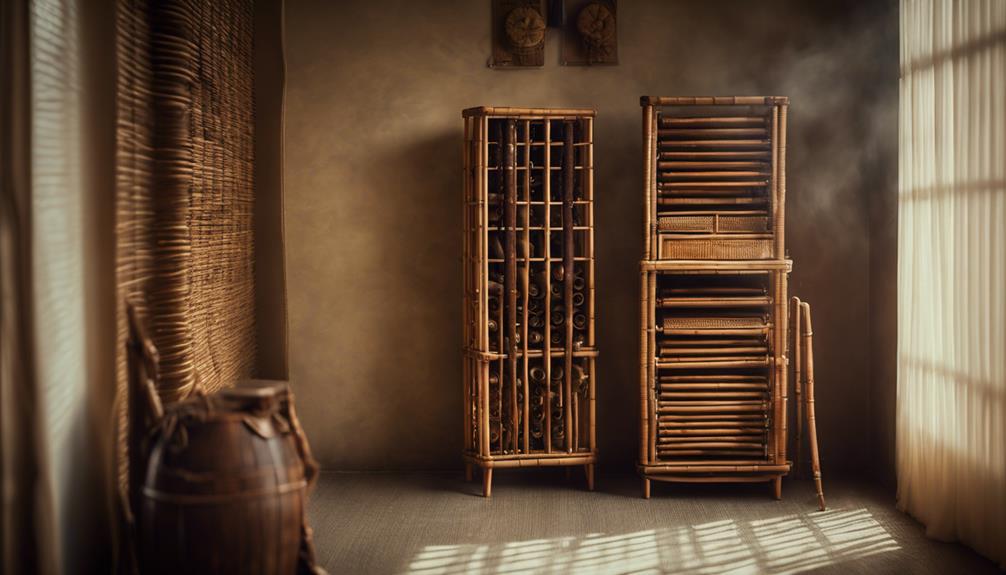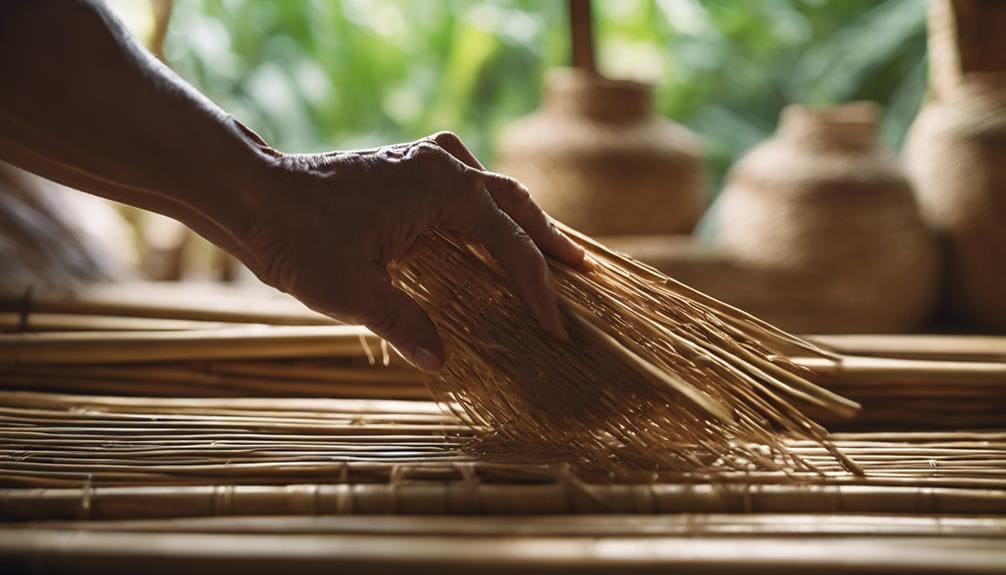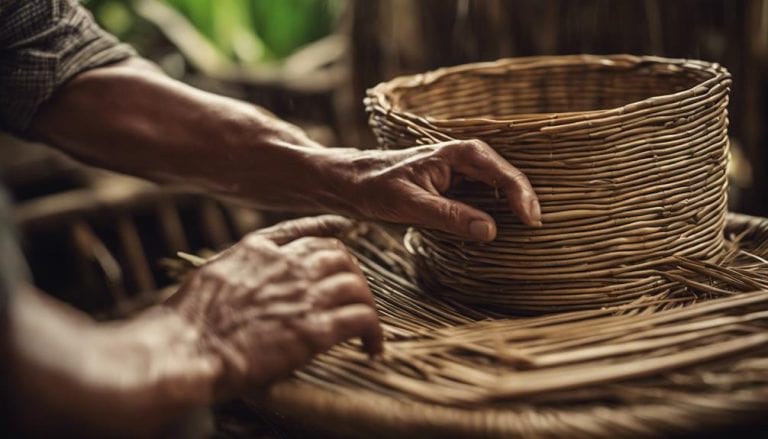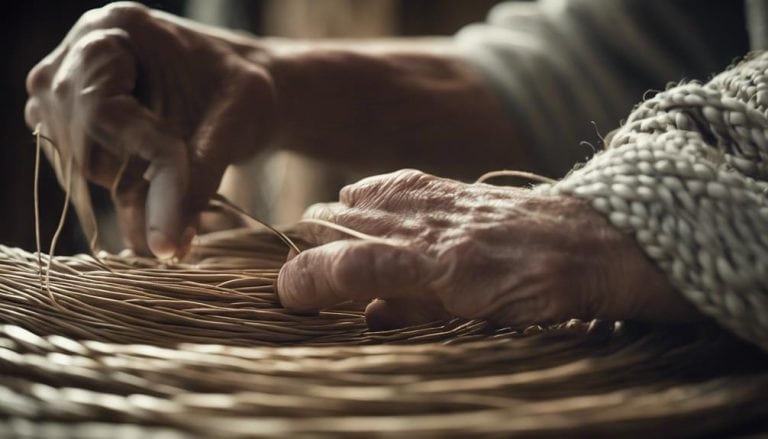Basket Weaving: Keeping Rattan Cane Fresh
Have you ever wondered how to keep rattan cane fresh for your basket weaving projects? It's a question that many enthusiasts ask, and the answer lies in proper storage and maintenance.
In this discussion, I will shed light on the importance of fresh rattan cane and provide you with some valuable tips on how to keep it in optimal condition. From the right storage techniques to cleaning methods and prevention strategies, we will explore various ways to ensure that your rattan cane remains flexible and durable.
So, let's dive into the world of basket weaving and discover the secrets to keeping your rattan cane fresh and ready for your next project.
Key Takeaways
- Fresh rattan cane is essential for successful basket weaving, offering flexibility, durability, and ease of manipulation for intricate designs.
- Proper storage techniques, such as keeping cane in a cool, dry place and avoiding bending or warping, are crucial for maintaining its quality.
- Regular cleaning and preventative measures, like applying a protective sealant and inspecting for damage, help prevent deterioration of rattan cane.
- Enhancing the lifespan of rattan cane involves storing it properly, moisturizing regularly, and avoiding extreme temperature changes and moisture exposure.
Importance of Fresh Rattan Cane
Fresh rattan cane is essential for successful basket weaving due to its flexibility, durability, and ability to be easily manipulated for intricate designs. When it comes to weaving a basket, the quality of the rattan cane plays a crucial role in achieving the desired results. The flexibility of fresh rattan cane allows for smooth and seamless weaving, ensuring that the basket holds its shape and structure. Its pliability allows the weaver to create intricate patterns and designs, adding a touch of artistry to the final product.
Using fresh rattan cane also ensures the durability of the woven basket. The natural properties of the cane make it resistant to breakage and snapping, resulting in a more robust finished product. This durability is especially important for baskets that will be used for carrying heavy items or for outdoor purposes.
Furthermore, fresh rattan cane is easier to manipulate compared to dried or aged cane. The moisture content in fresh cane makes it more malleable, allowing for easier shaping and weaving. This makes it ideal for creating complex designs and patterns that require precise manipulation of the cane.
Tips for Proper Rattan Cane Storage

To properly store rattan cane, it's important to follow these tips for maintaining its quality and preventing damage. Rattan cane, being the primary material used for weaving techniques, requires proper storage solutions to ensure its longevity.
Firstly, it's crucial to store rattan cane in a cool, dry place away from direct sunlight. This helps prevent drying out and discoloration, ensuring that the cane stays fresh and pliable for weaving.
Additionally, it's essential to keep the cane in a well-ventilated area to avoid moisture buildup and potential mold growth. Adequate air circulation is necessary to maintain the integrity of the cane, especially for intricate weaving patterns that require a tight weave.
When storing rattan cane, it's advisable to keep it in a vertical position to prevent bending or warping over time. This helps preserve the cane's shape and prevents any potential damage.
Lastly, it's essential to avoid stacking heavy objects on top of rattan cane bundles. This ensures that the cane retains its original form and isn't crushed under the weight. Consider using a dedicated storage rack or stand designed specifically for rattan cane to ensure proper air circulation and easy access to the different types of cane.
Cleaning Techniques for Rattan Cane

When cleaning rattan cane, it's important to use gentle techniques to preserve the material's integrity and prevent damage. Rattan cane is a popular weaving material used in basket weaving and cane weaving. Its open weave structure allows for intricate designs and patterns to be created during the weaving process.
To clean rattan cane, start by removing any dust and debris using a soft brush or vacuum with a brush attachment. Be gentle to avoid causing any damage to the delicate rattan strands. For surface dirt, use a cloth dampened with a mild soap and water solution to wipe the rattan cane. Avoid using harsh chemicals or abrasive cleaners as they can cause the material to deteriorate.
After cleaning, make sure to dry the rattan cane thoroughly to prevent moisture damage and mold growth. Regularly inspect and clean your rattan cane furniture to maintain its appearance and longevity. By following these cleaning techniques, you can help preserve the beauty of this traditional craft for years to come.
Preventing Rattan Cane Deterioration

Storing rattan cane in a cool, dry place away from direct sunlight is crucial to prevent deterioration and maintain its structural integrity. Here are four important tips to prevent rattan cane deterioration:
- Avoid exposing rattan cane to moisture or humidity: Moisture and humidity can lead to mold growth and weaken the material. Keep rattan cane away from areas prone to moisture, such as bathrooms or basements.
- Use a protective sealant or finish: Applying a protective sealant or finish on rattan cane can shield it from environmental factors, such as UV rays and moisture. This helps to prolong its lifespan and maintain its appearance.
- Regularly clean rattan cane: Use a soft cloth to gently clean the rattan cane, removing any dust and debris that can contribute to degradation over time. Avoid using harsh chemicals or abrasive materials that can damage the cane.
- Rotate and inspect rattan cane periodically: To ensure even exposure to light and air, rotate the rattan cane periodically. This reduces the risk of discoloration and damage caused by prolonged exposure to sunlight. Additionally, inspect the cane for any signs of wear or damage, and address them promptly to prevent further deterioration.
Enhancing the Lifespan of Rattan Cane

Properly caring for rattan cane is essential in enhancing its lifespan and ensuring its long-term durability. When it comes to basket weaving, one of the most important aspects is the quality and longevity of the rattan cane used. To start, it's crucial to store rattan cane in a cool, dry place away from direct sunlight. This prevents drying out and cracking, which can significantly shorten its lifespan. Regular moisturizing is also necessary to maintain flexibility and prevent brittleness. Applying a light coating of linseed oil or furniture polish is recommended to keep the cane supple and strong.
Furthermore, it's important to avoid exposing rattan cane to extreme temperature changes or moisture. These conditions can lead to mold growth and weaken the material over time. Additionally, it's essential to clean rattan cane regularly to remove dirt and dust. Using a soft cloth dampened with a mild soap solution is sufficient for this task. It's crucial to be gentle during the cleaning process to avoid damaging the surface of the cane.
Lastly, it's vital to inspect rattan cane periodically for signs of wear or damage. Addressing any issues promptly will help prolong its lifespan and usability. If any parts of the cane show signs of weakness or damage, they should be repaired or replaced as soon as possible.
Frequently Asked Questions
How Do You Keep Wicker Baskets From Getting Mouldy?
To prevent mold growth on wicker baskets, I suggest following best storage practices by keeping them in a dry, well-ventilated area. Regularly clean them with a damp cloth and mild soap, and consider using protective sprays to avoid moisture buildup.
How Do You Preserve Wicker Baskets?
To preserve wicker baskets, I recommend using natural oils for protection and cleaning regularly with gentle techniques. Storing them properly in a cool, dry place and preventing insect damage will ensure their longevity. Try DIY preservation solutions for added care.
How Long to Soak Reeds for Basket Weaving?
I soak reeds for basket weaving for the proper duration to ensure pliability and flexibility. It's important to adjust soaking times based on thickness and bending ability. Over soaking can lead to weakened reeds. Alternative preservation methods and proper storage are best practices.
How Do You Restore Wicker Baskets?
To restore wicker baskets, repair any damage by reweaving with matching materials. Clean stains with a soft brush or cloth. Enhance color with a protective coating. Strengthen the structure by allowing the cane to dry thoroughly. Prevent unraveling by applying a sealant.
Conclusion
In conclusion, maintaining the freshness of rattan cane is crucial for successful basket weaving.
By storing it properly in a cool, dry place away from sunlight and moisture, and regularly misting it to prevent drying out, we can ensure its flexibility and prevent deterioration.
With these simple techniques, we can enhance the lifespan of rattan cane, allowing us to create high-quality baskets that will stand the test of time.







